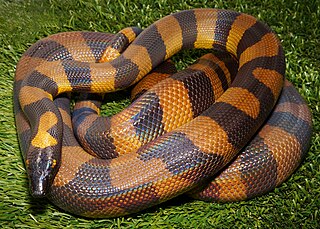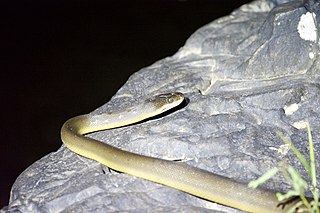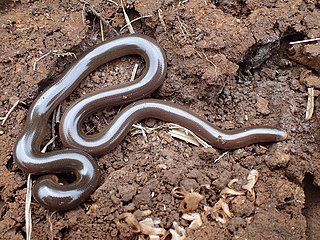
Loxocemus bicolor, the sole member of the monotypic family Loxocemidae and commonly known as the Mexican python, Mexican burrowing python and Mexican burrowing snake, is a species of python-like snake found in Mexico and Central America. No subspecies are currently recognized. Analyses of DNA show that Loxocemus is most closely related to the true pythons and the sunbeam snakes.

Xenopeltis, the sunbeam snakes, are the sole genus of the monotypic family Xenopeltidae, the species of which are found in Southeast Asia. Sunbeam snakes are known for their highly iridescent scales. Three species are recognized, each one with no subspecies. Studies of DNA suggest that the xenopeltids are most closely related to the Mexican burrowing python and to the true pythons (Pythonidae).

The Sumatran short-tailed python is a species of the family Pythonidae, a nonvenomous snake native to Sumatra.

The black-headed python is a species of snake in the Pythonidae. The species is endemic to Australia. No subspecies are currently recognized.

The Bismarck ringed python is a species of snake in the genus Bothrochilus found on the islands of the Bismarck Archipelago. No subspecies are recognized.

Craspedocephalus macrolepis, commonly known as the large-scaled pit viper, is a venomous pitviper species endemic to the Southern Western Ghats of South India. No subspecies are currently recognized.

Calloselasma is a monotypic genus created for a venomous pit viper species, Calloselasma rhodostoma, which is endemic to Southeast Asia from Thailand to northern Malaysia and on the island of Java. No subspecies are currently recognized.

The Round Island burrowing boa is an extinct species of snake, in the monotypic genus Bolyeria, in the family Bolyeriidae. The species, which was endemic to Mauritius, was last seen on Round Island in 1975. There are no recognized subspecies.

The rough-scaled python is a large-scaled python species endemic to Australia. No subspecies are currently recognized.

The water python is a python species found in Australia and Papua New Guinea. No subspecies are currently recognized. Like all other pythons, it is not venomous.

Ovophis okinavensis, commonly known as the hime habu (ヒメハブ), Ryukyu Island pit viper, and the Okinawan pitviper, is a venomous pitviper species found in the Ryukyu Islands of Japan. No subspecies are currently recognized.

Trimeresurus sumatranus is a venomous pitviper species found in Thailand, Malaysia and Indonesia. Arboreal, its coloration is pale green with a red tail. Common names include Sumatran pitviper, Sumatran tree viper, and Sumatran pit viper.

Trimeresurus hageni, commonly known as the Hagen's pit viper, is a species of pit viper, a venomous snake, in the subfamily Crotalinae of the family Viperidae. The species is endemic to Southeast Asia. There are no subspecies that are recognized as being valid.
Xenopeltis hainanensis is a non-venomous sunbeam snake species found in China and Vietnam. This is a primitive snake known for its highly iridescent scales. No subspecies are recognized.

The prong-snouted blind snake is a species of non-venomous worm-like burrowing snakes belonging to the Typhlopidae family. It is endemic to central southern, continental Australia.

Bibron's blind snake is a species of snake in the family Typhlopidae. The species is native to southern Africa.
Conrad's worm snake is a species of snake in the family Typhlopidae. The species is endemic to Indonesia.
Typhlops hectus is a species of snake in the family Typhlopidae. It is endemic to southwestern Haiti and is known from the Tiburon Peninsula and the island of Grand Cayemite, with an isolated record from Gonâve Island. Specimens of uncertain status are known further northeast, in an area extending into the Dominican Republic; whether these belong to Typhlops hectus or an undescribed species is pending further investigations.

Afrotyphlops schlegelii, commonly known as Schlegel's beaked blind snake or Schlegel's giant blind snake, is a species of snake in the family Typhlopidae. The species is endemic to eastern and southern Africa, and bears the distinction of being the world's largest typhlopid. It is harmless to humans and lives exclusively on a diet of termites.

D'Albertis' python, also known commonly as D'Albert's water python or the northern white-lipped python, is a species of python, a non-venomous snake in the family Pythonidae. The species is endemic to New Guinea. There are no subspecies that are recognized as being valid.



















